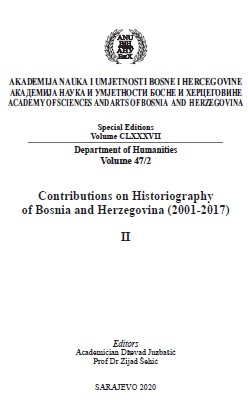Muzeografija i historiografija bosanskohercegovačke umjetnosti u postsocijalističkom stanju krize
Museography and Historiography of Bosnian- Herzegovinian Art in the Post-Socialist State of Crisis
Author(s): Asja Mandić
Subject(s): Cultural history, Museology & Heritage Studies, Government/Political systems, WW II and following years (1940 - 1949), Post-War period (1950 - 1989), Transformation Period (1990 - 2010), Politics and Identity, Peace and Conflict Studies, History of Art
Published by: Akademija Nauka i Umjetnosti Bosne i Hercegovine
Keywords: art history; historiography; identity; exhibition; museum; museography; socialism; transition; Art Gallery of Bosnia and Herzegovina; art;
Summary/Abstract: In the historiographical practice, museum has been viewed more and more as an institution which not only collects and exhibits evidence of historical knowledge, but acts as original contributor and actively participates in the construction of that knowledge. This paper examines the relationship between historiography and museography in the context of curating and writing history of art of Bosnia and Herzegovina. The crowning institution in this country, a paramount example of such relationship, is the Art Gallery of Bosnia and Herzegovina, which was founded by the socialist government of the People’s Republic of Bosnia and Herzegovina in 1946, right after WWII, as a mechanism for materialization of its authority and its powers and its conscious political didactic. Established as the most authoritative institution in the field of visual art, it regulated public sphere of art, and along with other museum institutions of the republic, it actively participated in the construction of its distinctive artistic tradition, its history as well as cultural identity. The gallery and is curators, engaged in systematic research, evaluation and presentation of Bosnian and Herzegovinian art, were actively involved in writing its history. The prominence of this institution and its exhibitions, especially the retrospective ones — that provided the curatorial representation of history and the first narratives on the development of modern art in Bosnia and Herzegovina — has been materialized through the four publications that still represent the only surveys of modern art of this country. Along with giving the original contribution to the history of art, this institution also played an important role in repositioning the art of Bosnia and Herzegovina from the margin to the centre of Yugoslav cultural scene in the 1980s. The collapse of socialism, that went hand in hand with the breakup of Yugoslav state and independence of Bosnia and Herzegovina, followed by the brutal war (1992–1995), horrible destruction, human loss and ethnic cleansing, resulted in the complete economic and political breakdown, in the dysfunctional, destabilized and ethnically divided state.
Book: Prilozi o historiografiji Bosne i Hercegovine (2001–2017) II
- Page Range: 257-276
- Page Count: 20
- Publication Year: 2020
- Language: Bosnian, Croatian, Serbian
- Content File-PDF

